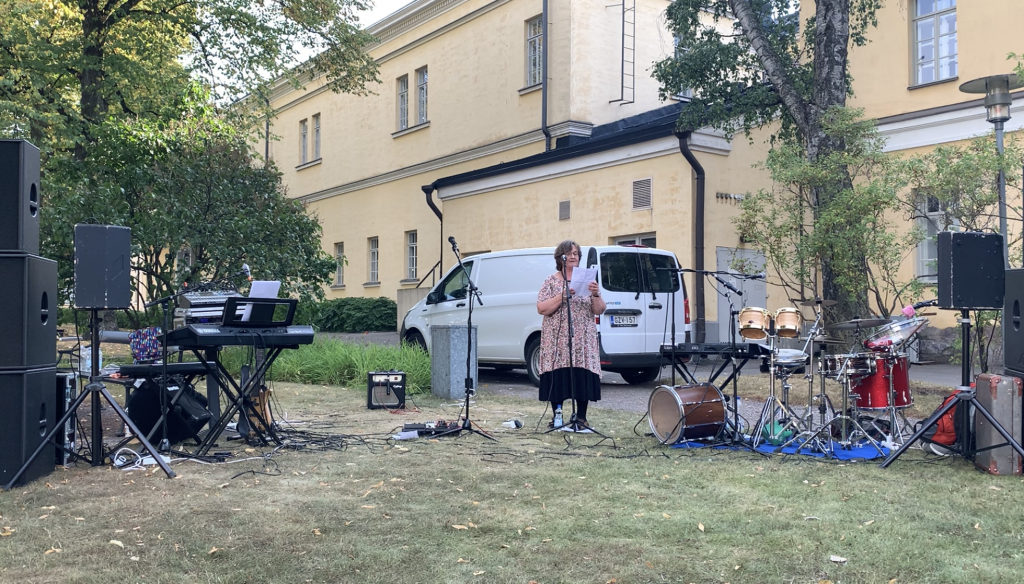Authors: Kirsti Salmi-Niklander, Marija Dalbello, Lotta Leiwo, Saku Pinta and John Westmoreland
Music, Research, and Activism Conference 2023
T-Bone Slim project’s researchers Kirsti Salmi-Niklander (PI), Lotta Leiwo (research assistant), Saku Pinta, Marija Dalbello and musician John Wesmoreland held a T-Bone Slim themed roundtable at Music, Research, and Activism Conference on 11 May 2023. The conference brought together researchers and practitioners engaged in activism and knowledge production around music. This short conference report is combined from the roundtable abstracts.
Our project’s roundtable “T-Bone Slim – a songwriter, an activist and a hobo” was chaired by Saijaleena Rantanen who first introduced the project and T-Bone Slim’s life to the hybrid audience. In the first presentation, PI Kirsti Salmi-Niklander and research assistant Lotta Leiwo discussed about music and poetry in Ashtabula and Erie during T-Bone Slim’s childhood and youth. Their analysis focuses in the Finnish-language books and newspapers published in Ashtabula in the late 19th century, preserved in the National Library of Finland. These fragmentary materials provide some new perspectives to the transnational influences of T-Bone Slim’s poetry. For example, he uses religious satire but also seems to compare himself to the Christ that was often called “Jerusalem Slim” in IWW context. Christ was considered as the first radical and religion had just misinterpreted his message. Salmi-Niklander have observed radical re-evaluations of Christ’s life also in Finnish working-class writing during the same period. Religion is an interesting perspective to Slim’s texts when we know his connection to religious temperance movement – a fact that has been discovered in this project. Furthermore, both Finnish and transnational cultural influences can be observed in T-Bone Slim’s writing: these include the use oral and hybrid genres (proverbs, wellerisms, riddles, rhymes), neologisms and language-twists.
Saku Pinta has observed apologies in the Finnish-language translations of T-Bone Slim’s texts in the Finnish-language IWW daily newspaper Industrialisti. Pinta spoke in his presentation about T-Bone Slim’s forgotten contemporaries and colleagues in the IWW Movement. In his presentation “The Mysteries of Other Popular Wobblies”, Saku Pinta first gave an overall context of the music and culture of the IWW with reference to two of T-Bone Slim’s lesser-known contemporaries: the Finnish American songwriter and poet George Blad and Canadian songwriter and humourist Pork Chop Slim. Pinta explored themes of anonymity, class, and cultures of resistance within the many worlds that T-Bone Slim inhabited.
The working-class poets who wrote about incarceration or migratory life often intended their poetry to be sung to familiar Christian tunes or known popular melodies. Focusing on the period of the late 1910s and early 1920s, Marija Dalbello discussed several narrative poems and ballad-like compositions and presented a preliminary analysis of ”The Rebel Worker group poets” who were active in the late 1910s and early 1920s. They were associated with Leland Sanford Chumley, an IWW activist and editor/business manager of The Rebel Worker, a New-York based bi-weekly newspaper. For example, “My Wandering Boy” is a poem about a jailed migrant worker (‘wandering boy’) intended for public recitation. “We’ll Be There” is a Lew Maisel poem to be sung to the “tune” of T-bone Slim’s “They go wild, simply wild, over me” (itself a parody of a popular 1917 song). Whether performed in barrooms, ballrooms, protests, or jail, these forms reveal a sensibility that Jacques Rancière identifies in the working-class emancipation of the body.
Lastly, musician, researcher, and great grandnephew of T-Bone Slim, John Westmoreland, performed new renditions of some of his Finnish American relative’s published and unpublished songs and poems. Brief reflections and commentary was given between the musical performances as well as an introduction consisting of T-Bone Slim’s own words as printed in his April, 5th 1924 column in the Industrial Worker “Mostly Song”:
“Now, it happens that I have written a few songs —a few songs as rotten as the system itself —no more and no less —ROTTEN. And, I maintain that under proper conditions my songs would have been SWEET as the voicings of an unsuccessful candidate cooing under the protecting wings of the administration. And since this be so and since my songs can not be blamed for the conditions that are, I stand unsullied of any taint of responsibility for the terrible straits in which labor finds itself today and the singing of my songs can not make things any worse than they are.”

For us, Music, Research, and Activism Conference was a “warm-up” for the upcoming T-Bone Seminar we are holding at Kälviä and Kokkola in August 18–19. This time, on MRA conference most of us met online as we usually do every month when we have our project meeting, but in August we finally meet in person here in Finland.
In the seminar, we will give longer presentations on the topics we have been researching during the project but also offer a lot of very interesting cultural programme with art, music and storytelling. The seminar programme will be hybrid so one can follow the presentations via Zoom as well as in person. Cultural programme is available only on site at Jokikylätalo at Kälviä on 18 August and at Kahvila Saha at Kokkola on 19 August. The programme will be published on June 1 on our website’s event page. On that date, the registration for the seminar opens as well. We hope to meet you there!



